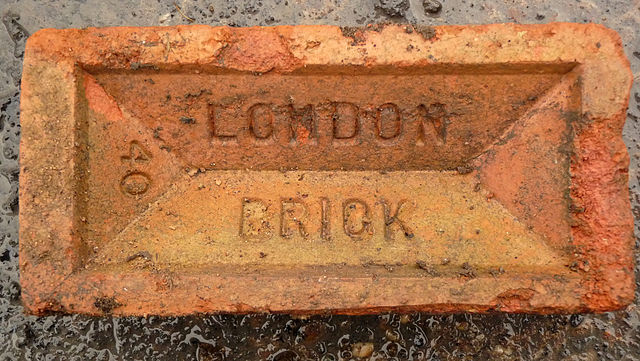Which way up should you lay a brick?
Bricks are small rectangular blocks that can be used to form parts of buildings, typically walls. Bricks are often completely solid, but they can also have holes perforated through them to reduce the amount of material used.
If bricks are perforated, or completely solid, it generally does not matter which way up they are laid.
However, some bricks have an indentation on one surface (or on two opposing surfaces). This is commonly called a ‘frog’.

|
| By Nottsexminer - London Brick Company #3, CC BY-SA 2.0, https://commons.wikimedia.org/w/index.php?curid=32725373 |
The frog reduces the amount of material used to form the brick, makes it easier to remove from the form, and gives the completed wall better shear resistance. It may also help heat reach the centre of clay bricks in the kiln.
It is thought that the word frog is a translation of the Dutch word 'kikker' and refers to a kicker placed in the bottom of the wooden boxes traditionally used to make clay bricks, which forced the clay material outwards when the brick was being formed.
The frog must be filled with mortar when bricks are laid otherwise the structural, thermal and acoustic performance of the wall can be affected. For this reason it is best practice to lay bricks with the frog facing upwards so that it is easy to fill completely and so that the mortar does not fall out when it is being laid.
Where there are two frogs, the larger frog should face upwards.
[edit] Related articles on Designing Buildings
- Airbrick.
- Aircrete blocks.
- Basic brickwork replacement.
- Blockwork.
- Brick.
- Brick strip foundation.
- Brick veneer.
- Cavity tray.
- Cavity wall.
- Damp-proof course.
- Defects in brickwork.
- Efflorescence.
- Frog.
- How to lay bricks.
- Mortar.
- Pointing.
- Spalling.
- Testing bricks.
- Treating brickwork with sealant or water repellent.
- Types of brick bonding.
- Types of bricks.
Featured articles and news
The UK's Modern Industrial Strategy: A 10 year plan
Previous consultation criticism, current key elements and general support with some persisting reservations.
Building Safety Regulator reforms
New roles, new staff and a new fast track service pave the way for a single construction regulator.
Architectural Technologist CPDs and Communications
CIAT CPD… and how you can do it!
Cooling centres and cool spaces
Managing extreme heat in cities by directing the public to places for heat stress relief and water sources.
Winter gardens: A brief history and warm variations
Extending the season with glass in different forms and terms.
Restoring Great Yarmouth's Winter Gardens
Transforming one of the least sustainable constructions imaginable.
Construction Skills Mission Board launch sector drive
Newly formed government and industry collaboration set strategy for recruiting an additional 100,000 construction workers a year.
New Architects Code comes into effect in September 2025
ARB Architects Code of Conduct and Practice available with ongoing consultation regarding guidance.
Welsh Skills Body (Medr) launches ambitious plan
The new skills body brings together funding and regulation of tertiary education and research for the devolved nation.
Paul Gandy FCIOB announced as next CIOB President
Former Tilbury Douglas CEO takes helm.
UK Infrastructure: A 10 Year Strategy. In brief with reactions
With the National Infrastructure and Service Transformation Authority (NISTA).
Ebenezer Howard: inventor of the garden city. Book review.
The Grenfell Tower fire, eight years on
A time to pause and reflect as Dubai tower block fire reported just before anniversary.
Airtightness Topic Guide BSRIA TG 27/2025
Explaining the basics of airtightness, what it is, why it's important, when it's required and how it's carried out.
Construction contract awards hit lowest point of 2025
Plummeting for second consecutive month, intensifying concerns for housing and infrastructure goals.
Understanding Mental Health in the Built Environment 2025
Examining the state of mental health in construction, shedding light on levels of stress, anxiety and depression.





















